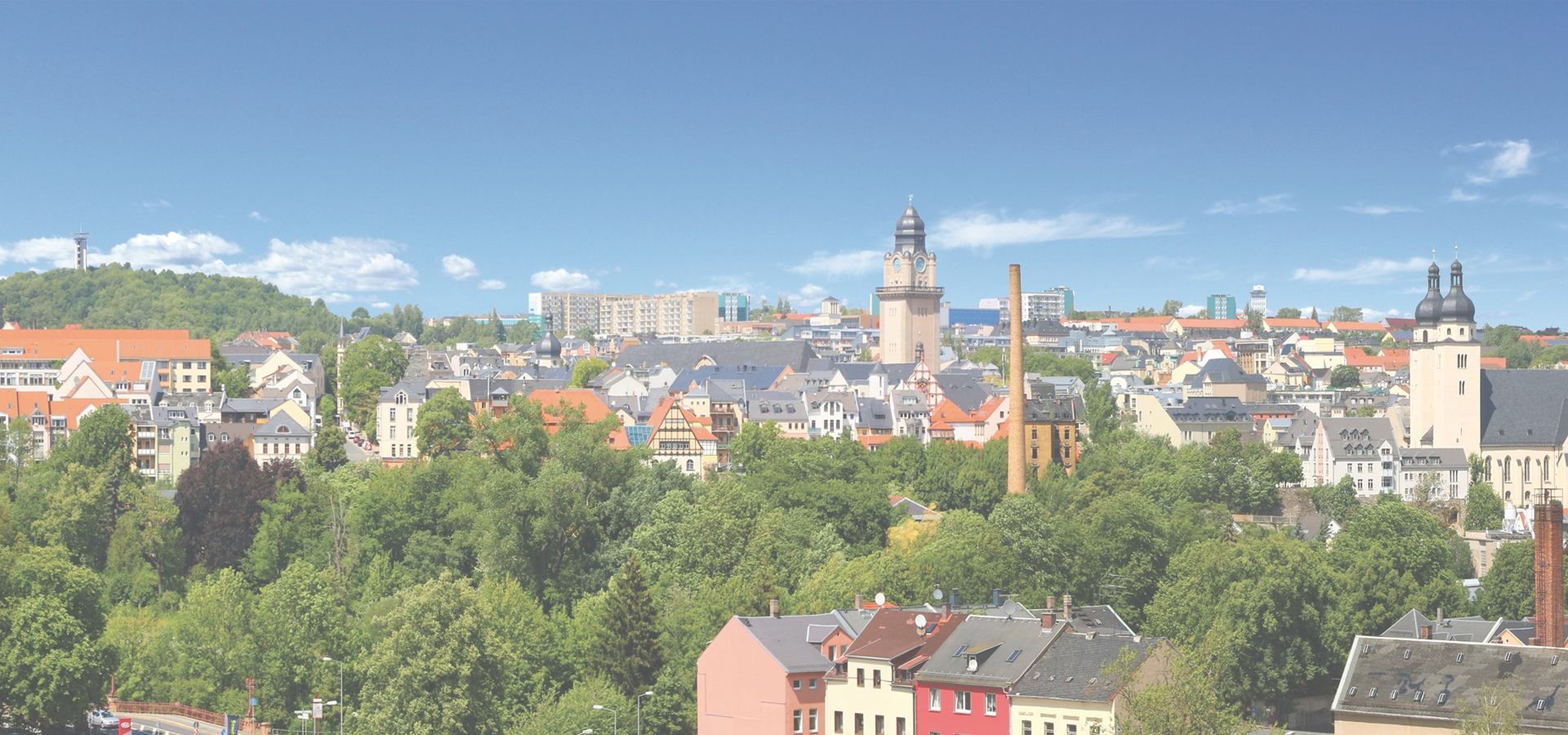Plauen, Saxony, Germany
🇩🇪 Plauen is, with around 65,000 inhabitants, the fifth-largest city of the Free State of Saxony, the second-largest city of the Vogtland, as well as the largest city in the Saxon Vogtland. The city lies on the Whiter Elster River, in the Central Vogtlandian Hill Country. Plauen is the south-western-most city of a string of cities sitting in the densely populated foreland of the Elster and Ore Mountains, stretching from Plauen in the south-west via Zwickau, Chemnitz and Freiberg to Dresden in the northeast. It is the capital of the Vogtland District. Plauen borders Thuringia to the north, and it is also situated near the Saxon border with Bavaria and the Czech Republic.
Although being a Saxon city, the regional Vogtlandian dialect spoken in Plauen is a (Saxon-influenced) East Franconian variant related to the dialects of neighbouring Franconia in Bavaria. The name of the city as well as the names of many of its boroughs are of Slavic origin. Plauen and the surrounding Saxon Vogtland are known as the centre of the German embroidery and lace industry.
History Plauen was founded by Polabian Slavs in the 12th century as "Plawe" and was passed to the Kingdom of Bohemia in 1327. The town was captured by the Archbishop of Magdeburg, Lippold von Bredow, in 1384. In 1466, it was passed to Albertine Saxony and later in 1569 to the Electorate of Saxony. Plauen became incorporated into the Kingdom of Saxony in 1806 during the Napoleonic Wars, and in 1871 it became part of the German Empire.
In the late-19th century, Plauen became a centre of textile manufacturing, specialising in Chemical lace, called Plauen lace. Around 1910, Plauen, as an industrial 'boomtown' of the region, reached its population peak (1910 census: 121,000, 1912: 128,000). Plauen's population, however, has shrunk dramatically since the Second World War (1939: 111,000 inhabitants).
In the 1930s, Plauen hosted the first chapter of the Nazi Party outside of Bavaria. During the war, the Nazis operated a prison in the town, and three subcamps of the Flossenbürg concentration camp. 500 women, mostly Polish, but also Russian, Italian, French, Yugoslavian and Croatian, were imprisoned and used as forced labour in the first two subcamps, and 50 men from various countries were imprisoned in the third subcamp. It was occupied by American troops on 16 April 1945 but was left to Red Army on 1 July 1945. On December 15, 1945, the city issued 7 semi-postal postage stamps of its own to raise money for reconstruction.
From 1945 onwards, Plauen fell into the Soviet occupation zone of Germany, which later became the German Democratic Republic (1949-1990). Plauen hosted a large Red Army occupation garrison and, in the last years of the GDR (DDR), an officer school of the Border Guards ("Grenztruppen der DDR"). The first mass demonstration against the communist regime in the GDR began in Plauen on 7 October 1989; this was the beginning of a series of mass demonstrations across the country and ultimately led to the re-unification of Germany in 1990.
The exposé Fast Food Nation gives special mention to Plauen as the first city of the GDR to have a McDonald's restaurant following the collapse of the Berlin Wall.
In the district reform of 1 July 2008, Plauen lost its urban district status and was merged into the district Vogtlandkreis.
Industry and infrastructure Plauen (Vogtland) Oberer Bahnhof lies on the Leipzig–Hof line. The section of this line through Plauen is part of the Saxon-Franconian trunk line running between Nürnberg, Hof, Plauen, Zwickau, Chemnitz and Dresden. The city had another station, Plauen (Vogtland) Unterer station (now defunct), on the Elster Valley Railway. There is a plan to rename the Oberer (Upper) station into Plauen Hauptbahnhof (Main Station).
Vogtlandbahn (Vogtland Railway), a regional train company, operates services from Plauen to Hof, Werdau, Chemnitz, Zwickau, Falkenstein and Adorf within Germany and Cheb in the Czech Republic. At these stations, there are other Vogtlandbahn services to Munich, Regensburg, Marktredwitz, Dresden and Leipzig within Germany and Karlovy Vary and Prague in the Czech Republic. A Vogtlandbahn Express Bus service runs between Plauen and Berlin Schönefeld Airport and Zoological Garden.
The Plauen Straßenbahn is a tramway that has 6 lines connecting the centre of city, Plauen-Tunnel stop, to the surrounding areas and the Oberer railway station.
Tourist Industry • Embroidery Machine Museum • Museum Plauener Spitze • Galerie e.O. plauen • Old City Hall • Elster Viaduct – second largest brick bridge in the world • Friedensbrücke – largest stone arch bridge in the world • Johanniskirche • Old Elster Viaduct – oldest bridge in Saxony • Malzhaus
Education and science Plauen is home to a University of Applied Sciences with about 300 students and a DIPLOMA Fachhochschule.
Plauen, Saxony, Germany

Plauen has a population of over 65,000 people. Plauen also forms one of the centres of the wider Saxony State which has a population of over 4,077,937 people.
To set up a UBI Lab for Plauen see: https://www.ubilabnetwork.org Twitter: https://twitter.com/UBILabNetwork
Twin Towns, Sister Cities Plauen has links with:
🇨🇿 Aš, Czech Republic 🇭🇺 Cegléd, Hungary 🇩🇪 Heilsbronn, Germany 🇩🇪 Hof, Germany 🇵🇱 Pabianice, Poland 🇱🇹 Šiauliai, Lithuania 🇩🇪 Siegen, Germany 🇦🇹 Steyr, Austria🇧🇪 La Louvière 50.494
🇵🇱 Strzelce Opolskie 50.5
🇫🇷 Le Touquet 50.519
🏴 Newton Abbot 50.529
🇵🇱 Krapkowice 50.475
🇺🇦 Solomianskyi 50.45
🇩🇪 Weiden in der Oberpfalz 12.161
Locations Near: Plauen 12.1167,50.4833
🇩🇪 Schleiz 11.817,50.583 d: 23.9
🇩🇪 Zwickau 12.498,50.715 d: 37.2
🇩🇪 Wunsiedel 12.017,50.017 d: 52.4
🇩🇪 Eisenberg 11.9,50.967 d: 55.9
🇩🇪 Altenburg 12.444,50.992 d: 61.1
🇩🇪 Tirschenreuth 12.337,49.878 d: 69.1
Antipodal to: Plauen -167.883,-50.483
🇹🇴 Nuku'alofa -175.216,-21.136 d: 16689.3
🇦🇸 Pago Pago -170.701,-14.279 d: 15981.4
🇼🇸 Apia -171.76,-13.833 d: 15924.7
🇵🇫 Papeete -149.566,-17.537 d: 16005.8
🇺🇸 Hilo -155.089,19.725 d: 12107.8
🇺🇸 Maui -156.446,20.72 d: 12018.3
🇺🇸 Maui County -156.617,20.868 d: 12004.3
🇺🇸 Wailuku -156.505,20.894 d: 11999.9